When it comes to chicken farming for eggs, choosing the best egg-laying chickens is crucial. The journey of how to raise chickens for eggs involves several essential factors, such as the chicken egg production cycle, their diet, and the environment in which they are raised. Organic chicken egg production is an approach where the birds are fed natural and chemical-free feeds, enhancing the eggs’ quality.
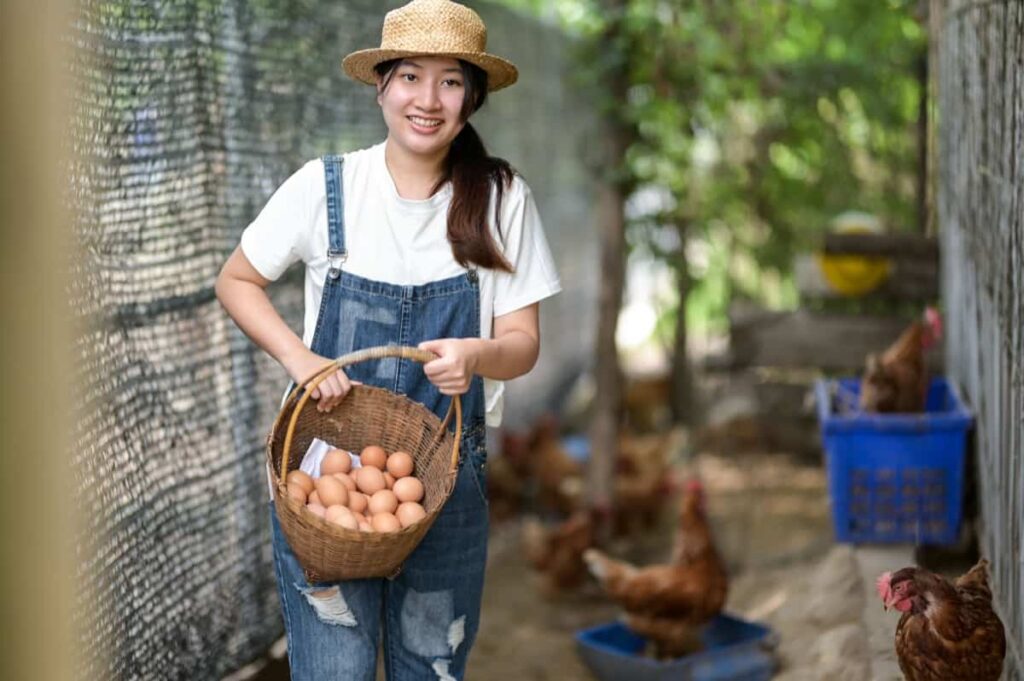
This also involves supplements to increase egg production in chickens and various foods that help boost their productivity. To optimize the process, a comprehensive understanding of how many eggs a hen lays in a year naturally and the frequency, such as how many eggs a chicken can lay in a week. It is also crucial to know when chickens stop laying eggs to manage the flock efficiently and when to introduce new layers for uninterrupted egg production.
18 Best Egg Laying Chickens
Leghorn
Leghorns are active and efficient foragers renowned for laying a substantial quantity of white eggs. With a slim body and a generally white feather (although other color variations exist), they are hardy birds that adapt well to various conditions. Leghorns can lay up to 280 eggs annually, making them prolific layers essential for a steady egg supply.
In case you missed it: 15 Best Heritage Breed Chickens for Meat, Eggs and Dual-Purpose
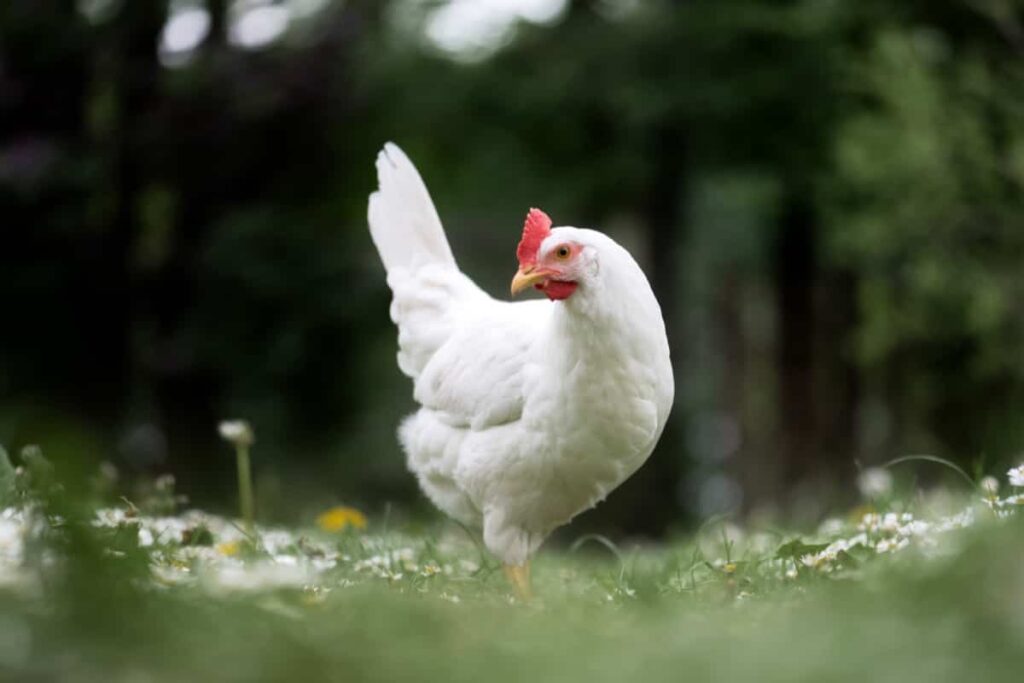
Brahma
Brahmas are large, attractive birds known for their size and feathered legs. They are cold-hardy and reliable layers of large brown eggs, with an annual production of 150-200 eggs. Brahmas are friendly and easy to manage, making them suitable for diverse settings, from backyards to larger poultry farms.
Rhode Island Red
Known for their remarkable resilience and adaptability, Rhode Island Reds are medium-sized birds with dark red bodies. They are popular for their consistent egg-laying ability, producing brown eggs. A Rhode Island Red hen can lay up to 200-300 eggs annually, making them an ideal choice for egg production. They’re also quite hardy, able to adapt to various climates and conditions, making them suitable for diverse geographical locations.
Plymouth Rock
Plymouth Rocks, characterized by their distinctive striped appearance, are multi-purpose birds known for their meat and egg-laying capabilities. They are friendly and easy to manage, laying brown eggs consistently. They can produce about 200-280 eggs annually, contributing reliably to the production cycle.
In case you missed it: Chicken Farming in India: Poultry Farming Cost, License, and Requirements to Start in India
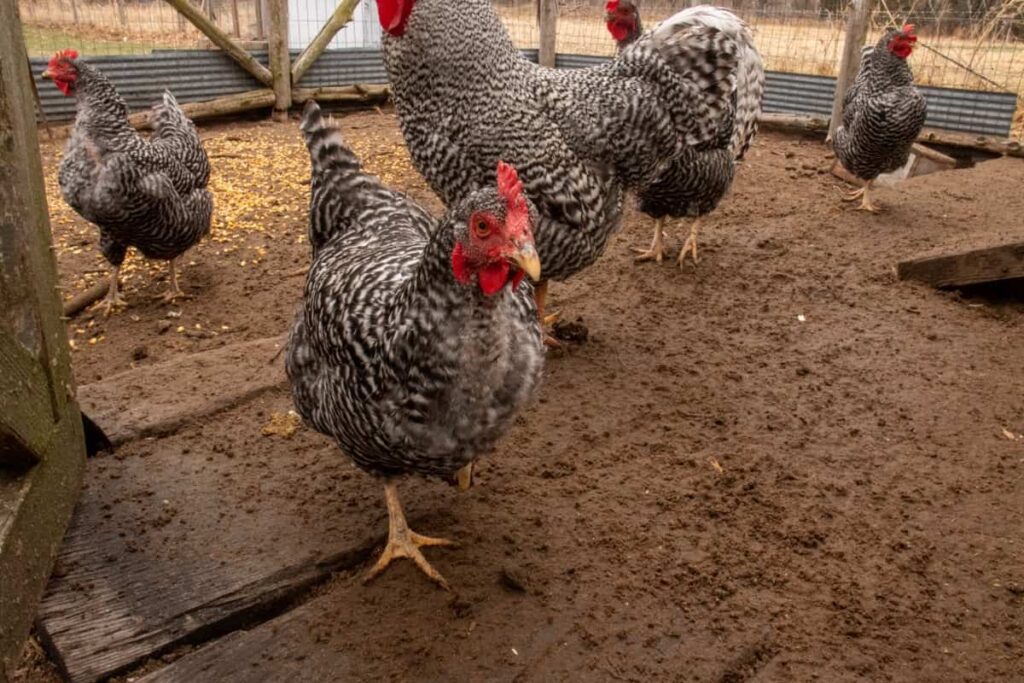
Sussex
Sussex chickens are appreciated for their pleasant temperament and adaptability. With various colors, the most common being red, white, and speckled, Sussex chickens are prolific layers, producing large brown eggs. Their egg-laying capacity ranges from 250-275 eggs per year, and they adapt well to various living conditions, making them suitable for both free-range and confined environments.
New Hampshire Red
The New Hampshire Red, a medium-sized bird with bright red plumage, is known for its early maturing, substantial meat production, and egg-laying abilities. These birds are hardy and robust, laying brown eggs consistently with an annual output of around 200-240 eggs, showcasing their reliability and usefulness in egg production.
Delaware
Delawares are primarily white with black neck and tail markings. They are friendly, calm, and excellent for meat and egg production. Delawares can lay about 200-280 large brown eggs annually, showing adaptability and persistence in their egg-laying patterns, suitable for steady egg production.
Australorp
Australorps are known for their gentle nature and shiny, black plumage. Originating from Australia, they hold a record for egg-laying, with a capacity to produce over 300 brown eggs annually. Their docile temperament makes them easy to manage, and their hardiness ensures they adapt well to different environmental conditions.
In case you missed it: 15 Best Electric Chicken Debeaking Machines: Price List Included
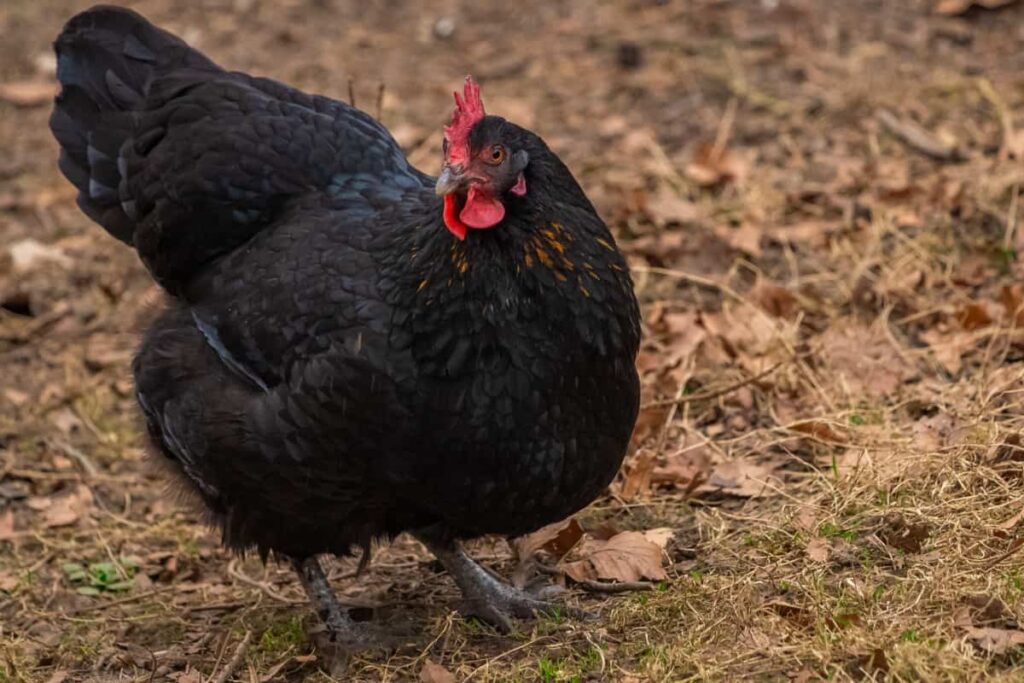
Easter Egger
Easter Eggers are admired for their ability to lay eggs in various colors, adding diversity to the egg basket. They are not a specific breed but are known for their unique egg colors, including blue, green, and sometimes even pink. Easter Eggers are generally hardy and adaptable, laying around 200-280 eggs annually, bringing a delightful variety to egg production.
Barnevelder
Barnevelders, with their beautiful brown-laced feathers, are known for laying dark brown eggs. They are sturdy, adaptable, and can produce around 200 eggs annually. Their attractive appearance and the unique color of their eggs make them a standout choice for a varied and vibrant egg basket.
Faverolles
Faverolles are friendly and gentle chickens known for their beard, muff, and five toes. They are consistent layers of tinted eggs, with an annual production of around 200-240 eggs. Their charming appearance and steady egg-laying ability make them a delightful addition to any flock.
Golden Comet
Golden Comets are hybrids known for their exceptional egg-laying abilities. They are friendly, easy to handle, and adapt well to various living conditions. Golden Comets lay brown eggs, and their production can go up to 250-300 eggs annually. Their adaptability and high egg production make them ideal for those looking to optimize egg laying in their flocks.
Wyandotte
Wyandottes are beautifully patterned birds that are known for their robust nature. They can withstand cold climates and consistently lay eggs during colder seasons. Wyandottes typically produce brown eggs, with an annual egg production of around 200. Their attractive appearance and steady egg-laying make them popular among poultry keepers.
In case you missed it: 12 Best Chicken Pluckers: Defeathering Machine Price List Included
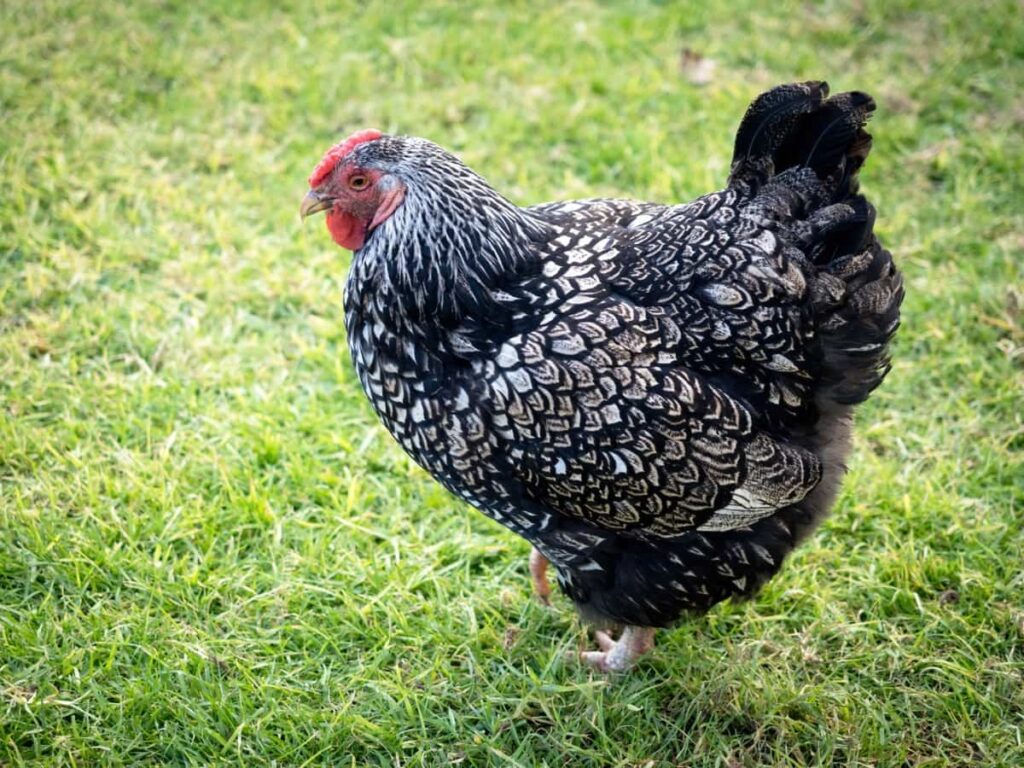
Isa Brown
Isa Browns are affectionate birds renowned for their incredible egg-laying abilities. They have reddish-brown plumage and are known to lay approximately 300-350 brown eggs yearly. Isa Browns adapt well to various environments and exhibit consistent egg-laying patterns, making them invaluable in high production.
Silver Laced Wyandotte
These attractive chickens come with white feathers laced with black, adding aesthetic appeal to your flock. Silver-laced Wyandottes are hardy birds, laying about 200 brown eggs annually. Their adaptability to various climates and robust nature ensure a steady supply of eggs throughout different seasons.
Speckled Sussex
Speckled Sussex chickens are delightful birds known for their speckled plumage and adaptability. They are hardy and able to lay around 250-275 brown eggs annually. Their curious and friendly nature makes them easy to manage and a joyful addition to any poultry flock.
Buff Orpington
With their lovely golden-yellow plumage, Buff Orpingtons are not only appealing to the eye but also excellent layers. They produce large brown eggs, and their annual egg production is around 175-200. Their gentle and friendly nature makes them perfect for a backyard flock, and their adaptability makes them a solid choice for consistent egg layers.
In case you missed it: 15 Types of Black Chicken Breeds with Pictures: The Ultimate List for Your Backyard
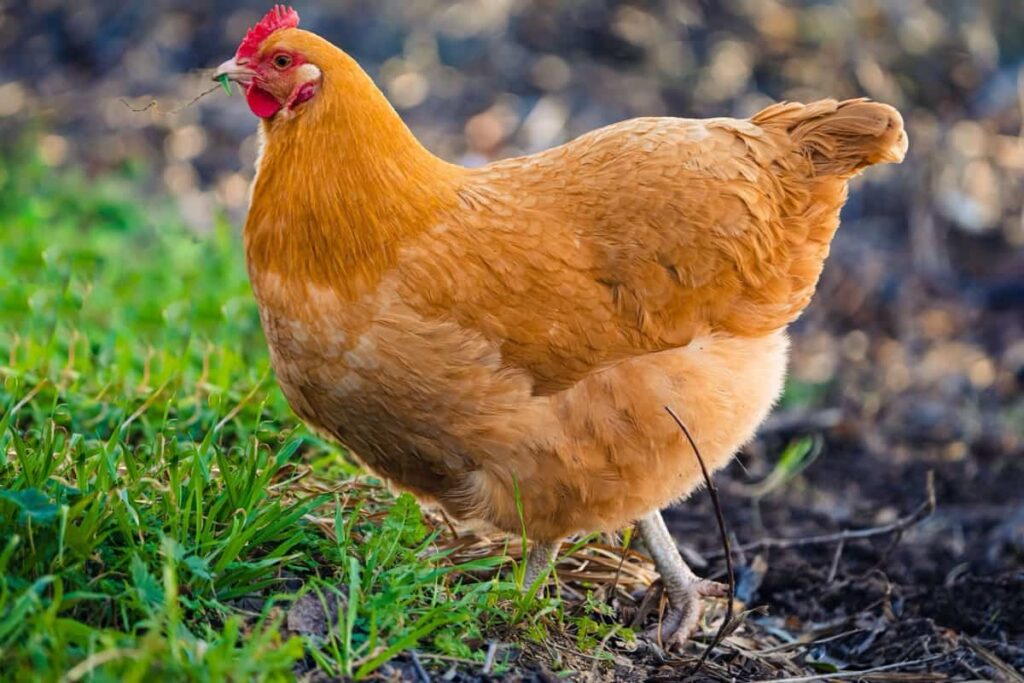
Marans
Marans are sought after for their dark chocolate-colored eggs, adding a unique variety to the egg basket. They are resilient, adaptable birds that lay approximately 150-200 eggs annually. Their unique egg color and robust nature make them an exciting choice for enhancing egg variety.
Foods That Increase Egg Production in Chickens
A well-balanced diet can significantly impact the egg production of chickens. Including various foods rich in proteins, vitamins, and minerals helps enhance egg production. Grains like corn, wheat, and leafy greens can be a good staple in their diet. Oyster or crushed eggshells can be added as a calcium supplement to ensure strong eggshells.
Boosting egg production in chickens can be helpful by giving them supplements such as vitamin D and omega-3 fatty acids. Garlic and probiotics added to their diet improve the immune system and boost overall health, supporting how to increase egg production in commercial layers. Incorporate foods like alfalfa, which has high nutritious value, to meet the nutritional needs essential for consistent egg laying.
Egg Laying Capacity: How Many Eggs Do Chickens Lay a Day?
Understanding the egg-laying capacity of chickens is fundamental in managing and selecting the best layers for your flock. A healthy hen lays about five to seven eggs per week. However, this number can vary based on the breed and the conditions they are raised in. Knowing how many eggs a hen lays in a year naturally is also essential. Some of the high-producing breeds can lay up to 300 eggs annually. Certain factors, such as the chicken’s age, diet, and environment, influence their egg-laying capacity and regularity, directly affecting their production cycle.
Egg Laying Frequency: How Often Do Chickens Lay Eggs?
Egg-laying frequency varies among different breeds of chickens. On average, a chicken may lay an egg almost daily, translating to around five to seven eggs weekly. However, factors such as the chicken’s age, health status, and environmental conditions significantly determine how often chickens lay eggs. Proper care, adequate nutrition, and an optimized environment are essential to maintain a consistent egg-laying frequency and efficient chicken farming for eggs.
Best Dark Brown Egg Laying Chickens
When considering egg colors, the best dark brown egg-laying chickens are often a popular choice for their uniquely colored eggs. Breeds like the Rhode Island Red, Marans, and Barnevelders are known for their capacity to lay dark brown eggs. These breeds enhance the variety in egg colors and are also quite adaptive and hardy, making them suitable for various climates and environments. Including such varieties in your flock contributes to a diverse egg basket, making raising chickens for egg production more delightful and visually appealing.
Best White Egg Laying Chickens
White eggs are a common and popular choice among consumers, and having chickens that specialize in laying white eggs can be a boon for your poultry farm. Breeds such as the White Leghorn are exceptional layers of white eggs, producing a high number almost daily. These chickens adapt well to different environments and are known for their hardiness and resistance to common poultry diseases, making them excellent choices for consistent egg production.
A proper diet and ensuring adequate nutrients are essential to maintain their health and egg-laying capacity. Selecting breeds known for laying white eggs and ensuring they are raised in optimum conditions is crucial in maximizing productivity and ensuring a steady supply of white eggs for consumption.
First-Time Egg Laying: What Age Do Chickens Start Laying Eggs?
Understanding when chickens start laying eggs is crucial in effectively planning and managing your poultry farm. Generally, hens begin to lay eggs when they are about five to six months old, but this can vary based on the breed and individual health of the chicken. Providing them with a nutrient-rich diet and comfortable living conditions is essential as they age. Ensuring the chickens are healthy, stress-free, and well-nourished during this period promotes a smooth transition into the egg-laying phase, contributing to their overall productivity and longevity in egg production.
Types of Egg-Laying Chickens
When choosing the best egg-laying chickens, understanding the available types is essential. There are various breeds, each with unique characteristics, egg-laying capacities, and adaptability to environmental conditions. Some chickens excel in laying large quantities of eggs, while others may be prized for the color or size of the eggs they produce.
Breeds like Rhode Island Reds, Leghorns, and Plymouth Rocks are renowned for their excellent egg-laying abilities and hardiness, making them ideal choices for those looking to maximize egg production. Having a diverse array of chickens in your flock can also contribute to a varied and appealing assortment of eggs, enhancing the attractiveness of your produce.
Best Egg Laying Chickens for Backyard
For those who are keen on raising chickens in their backyards, selecting breeds that are adaptable, hardy, and good layers is essential. Backyard chickens are often chosen for their ability to produce eggs and consistent ease of management and care. Breeds like the Australorp, Sussex, and Orpington are excellent choices for backyard poultry as they are known for their friendly demeanor, hardiness, and consistent egg production.
These chickens are suitable for smaller spaces and are relatively easy to care for, making them ideal choices for those looking to enjoy fresh eggs from their backyard without requiring extensive experience or resources in poultry care.
When Do Chickens Stop Laying Eggs in Winter
The egg-laying pattern of chickens can be influenced by seasonal changes, with winter being a time when there might be a noticeable decline in egg production. During the colder months, chickens tend to lay fewer eggs due to decreased daylight hours and the energy being diverted towards maintaining body heat.
Ensuring the chickens are comfortable and warm and receiving adequate light during these months can help maintain a steady level of egg production. Changing what they eat to match their higher energy requirements and ensuring they get sufficient nutrients and calories can help keep egg production steady in the winter.
Best Egg Laying Chickens Chart
| Breed | Egg Color | Annual Egg Production |
| Rhode Island Red | Brown | 200-300 |
| Leghorn | White | 280 |
| Plymouth Rock | Brown | 200-280 |
| Sussex | Brown | 250-275 |
| Australorp | Brown | 300+ |
| Wyandotte | Brown | 200 |
| Easter Egger | Multicolored | 200-280 |
| Golden Comet | Brown | 250-300 |
| New Hampshire Red | Brown | 200-240 |
| Delaware | Brown | 200-280 |
| Isa Brown | Brown | 300-350 |
| Buff Orpington | Brown | 175-200 |
| Silver Laced Wyandotte | Brown | 200 |
| Speckled Sussex | Brown | 250-275 |
| Barnevelder | Dark Brown | 200 |
| Faverolles | Tinted | 200-240 |
| Marans | Dark Brown | 150-200 |
| Brahma | Brown | 150-200 |
Frequently Asked Questions (FAQ) on Egg Laying Chickens
What Foods Help Chickens Lay More Eggs?
Providing chickens with a balanced diet of protein, calcium, and essential vitamins boosts their egg-laying capacity. Incorporating grains, leafy greens, kitchen scraps, and a consistent supply of fresh water ensures chickens produce eggs more effectively and maintain overall health.
How Can I Increase My Chicken Egg Laying?
Ensuring a comfortable living environment, managing stress levels, and maintaining an optimum light schedule can enhance a chicken’s egg-laying frequency. Additionally, a diet rich in essential nutrients, regular health check-ups, and vaccinations contribute to increased egg production in chickens.
How Many Eggs Can 50 Layers Lay in a Day?
The daily egg production from 50 layers depends on the breed and its environment. On average, if a hen lays 5-6 eggs a week, 50 hens would lay approximately 40-45 eggs daily, considering some might not lay an egg daily due to various factors affecting their laying pattern.
How Many Eggs Will 200 Chickens Lay a Day?
For 200 layers, daily egg production can average between 150-180 eggs, considering that each hen might lay an egg 5-6 times a week. Factors such as the chicken’s breed, age, health, and environmental conditions will influence the number of eggs produced daily.
Conclusion
Choosing the best egg-laying chickens involves considering various factors such as the breed’s egg-laying capacity, adaptability, and temperament. By selecting suitable breeds and providing optimal care and nutrition, you can maximize your flock’s egg production, ensuring a consistent and bountiful supply of eggs.
- Budget Friendly Sheep Shed Ideas: Cheap and Low-Cost Tips
- How Much Do Cattle Farmers Make: Revenue Streams in Cattle Farming
- Management Pests and Diseases in Your Cotton Field
- Sheep Farming Business Plan for Beginners
- Aquaponic Farming at Home: A Step-By-Step Guide
- Profitable Village Farming Business Ideas in 2024
- High-Yield Aquaculture: Fast-Growing Fish for Farming
- Effective Fish Pond Construction Techniques for Beginners
- Irrigation and Water Management in Pineapple Farming
- Blossom to Harvest: Mastering Flowering and Pollination in Papaya Farming
- Pig Fattening Essentials: From Selection to Sale for Beginners
- Raising Wagyu Cattle: A Complete Guide for Premium Beef Production
- Soil Types and Their Water Holding Capacity
- Optimizing Irrigation Schedules for Coconut Groves for Enhanced Yield
- Espresso Your Garden: Coffee Grounds for Healthier Acid-Loving Plants
- The Best Soil Mix for Snake Plants: How to Mix Your Own Snake Plant Soil
- Green Thumb Success: Expert Tips for Cultivating Greenhouse Beans All Year Round
- Bloom All Year Round: The Ultimate Guide to Indoor Hyacinth Care
- Eco-Friendly Gardening: How to Make Liquid Fertilizer from Kitchen Waste
- Ultimate Guide to Grow Anise in Pots: Explore Seed Propagation to Harvesting
- Guide to Raising Chester White Pigs: Discover Breed Facts to Growth Management
- Mastering the Elegance: The Ultimate Guide to Weeping Cherry Tree Care, Planting, and Maintenance
- Ultimate Guide to Planting Garlic in Grow Bags: Growing Strategies for Beginners
- How to Fix Spider Plant Leaf-Related Problems: Natural and Organic Remedies
- 10 Reasons Why Your Tulsi Plant is Shedding Leaves: Home Remedies and Solutions
- Optimizing Growth and Yield: The Advantages of Palm Bunch Ash Fertilizer
- Utilizing Neem Oil Extract as a Natural Pesticide for Hydrangea
- From Soil to Harvest: Various Ways in Which Farmers Can Use AI Tools
- Steps to Encourage and Induce Citrus Flowers: A Comprehensive Guide
- How to Fix Snake Plant Leaf-Related Issues: Natural and Organic Remedies
- Transform Your Garden into a Fragrant Oasis with Raat Ki Rani (Night Blooming Jasmine)
- Discover the Ideal Chicken Breeds for Philippine Farms
- How to Create a Poultry Egg Farm Business Plan for Profits
- Grow Lemon Cucumbers Like a Pro: Insider Techniques for Bountiful Yields
- Ultimate Guide to Caring for Your Pink Princess Philodendron: Tips for Thriving Variegation
- Areca Nut Profit Per Acre: Calculating Yield and Cost of Cultivation
